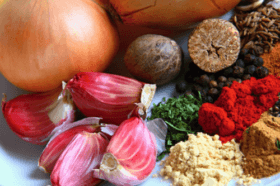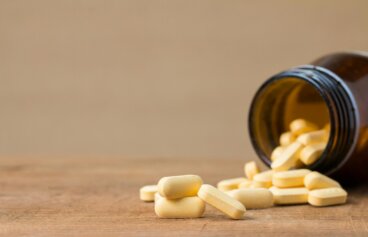Quercétine : sources et éventuels bienfaits

La quercétine est un flavonoïde, c’est-à-dire un pigment naturel que l’on peut trouver dans les fruits, les légumes, les céréales, le thé et le vin. Il existe des preuves scientifiques qui suggèrent que ces composés sont capables de réduire le risque de développer des maladies cardiaques et neurodégénératives.
Un autre avantage des flavonoïdes est leur capacité antioxydante. Néanmoins, bien qu’ils soient considérés comme sûrs, le dépassement de la dose de suppléments peut provoquer des maux de tête, des problèmes d’estomac et des picotements. Découvrez dans les lignes suivantes ce que vous devez savoir à ce sujet.
Les éventuels bienfaits de la quercétine
La quercétine est reconnue comme étant le flavonoïde le plus abondant dans l’alimentation. Voyons en détail comment elle peut être bénéfique pour la santé.
1. La quercétine diminue l’inflammation
Des recherches publiées dans The American Journal of Clinical Nutrition ont révélé que la quercétine peut réduire les marqueurs de l’inflammation, tels que le facteur de nécrose tumorale alpha (TNF-α) et l’interleukine-6 (IL-6).
De même, une étude chez des femmes atteintes de polyarthrite rhumatoïde a révélé que la prise de 500 milligrammes de cette substance est capable de réduire la raideur et la douleur matinale associées à la maladie.
De plus, il a été mis en évidence que les patients présentaient des marqueurs d’inflammation réduits. Toutefois, aussi prometteurs que soient ces résultats, des recherches supplémentaires sur ses propriétés anti-inflammatoires sont encore nécessaires.
La quercétine : un pigment naturel à fort potentiel
La quercétine est un flavonoïde qui se distingue par les différentes manières dont elle peut contribuer à la santé. Elle réduit l’inflammation, a pression artérielle, le risque de développer des troubles dégénératifs et atténue les symptômes d’allergie.
De plus, elle a très peu d’effets secondaires et est considérée comme un nutriment sûr. Le seul risque qui existe concerne les suppléments.
Toutes les sources citées ont été examinées en profondeur par notre équipe pour garantir leur qualité, leur fiabilité, leur actualité et leur validité. La bibliographie de cet article a été considérée comme fiable et précise sur le plan académique ou scientifique
- Panche, A. N., Diwan, A. D., & Chandra, S. R. (2016). Flavonoids: an overview. Journal of nutritional science, 5, e47. https://doi.org/10.1017/jns.2016.41
- Boots, A. W., Haenen, G. R., & Bast, A. (2008). Health effects of quercetin: from antioxidant to nutraceutical. European journal of pharmacology, 585(2-3), 325–337. https://doi.org/10.1016/j.ejphar.2008.03.008
- Chuang, C. C., Martinez, K., Xie, G., Kennedy, A., Bumrungpert, A., Overman, A., Jia, W., & McIntosh, M. K. (2010). Quercetin is equally or more effective than resveratrol in attenuating tumor necrosis factor-{alpha}-mediated inflammation and insulin resistance in primary human adipocytes. The American journal of clinical nutrition, 92(6), 1511–1521. https://doi.org/10.3945/ajcn.2010.29807
- Javadi, F., Ahmadzadeh, A., Eghtesadi, S., Aryaeian, N., Zabihiyeganeh, M., Rahimi Foroushani, A., & Jazayeri, S. (2017). The Effect of Quercetin on Inflammatory Factors and Clinical Symptoms in Women with Rheumatoid Arthritis: A Double-Blind, Randomized Controlled Trial. Journal of the american college of nutrition, 36(1), 9–15. https://doi.org/10.1080/07315724.2016.1140093
- Mlcek, J., Jurikova, T., Skrovankova, S., & Sochor, J. (2016). Quercetin and Its Anti-Allergic Immune Response. Molecules (Basel, Switzerland), 21(5), 623. https://doi.org/10.3390/molecules21050623
- Shishehbor, F., Behroo, L., Ghafouriyan Broujerdnia, M., Namjoyan, F., & Latifi, S. M. (2010). Quercetin effectively quells peanut-induced anaphylactic reactions in the peanut sensitized rats. Iranian journal of allergy, asthma, and immunology, 9(1), 27–34.
- Khansari, N., Shakiba, Y., & Mahmoudi, M. (2009). Chronic inflammation and oxidative stress as a major cause of age-related diseases and cancer. Recent patents on inflammation & allergy drug discovery, 3(1), 73–80. https://doi.org/10.2174/187221309787158371
- Yang, F., Song, L., Wang, H., Wang, J., Xu, Z., & Xing, N. (2015). Quercetin in prostate cancer: Chemotherapeutic and chemopreventive effects, mechanisms and clinical application potential (Review). Oncology reports, 33(6), 2659–2668. https://doi.org/10.3892/or.2015.3886
- Hashemzaei, M., Delarami Far, A., Yari, A., Heravi, R. E., Tabrizian, K., Taghdisi, S. M., Sadegh, S. E., Tsarouhas, K., Kouretas, D., Tzanakakis, G., Nikitovic, D., Anisimov, N. Y., Spandidos, D. A., Tsatsakis, A. M., & Rezaee, R. (2017). Anticancer and apoptosis‑inducing effects of quercetin in vitro and in vivo. Oncology reports, 38(2), 819–828. https://doi.org/10.3892/or.2017.5766
- Costa, L. G., Garrick, J. M., Roquè, P. J., & Pellacani, C. (2016). Mechanisms of Neuroprotection by Quercetin: Counteracting Oxidative Stress and More. Oxidative medicine and cellular longevity, 2016, 2986796. https://doi.org/10.1155/2016/2986796
- Sabogal-Guáqueta, A. M., Muñoz-Manco, J. I., Ramírez-Pineda, J. R., Lamprea-Rodriguez, M., Osorio, E., & Cardona-Gómez, G. P. (2015). The flavonoid quercetin ameliorates Alzheimer’s disease pathology and protects cognitive and emotional function in aged triple transgenic Alzheimer’s disease model mice. Neuropharmacology, 93, 134–145. https://doi.org/10.1016/j.neuropharm.2015.01.027
- Lu, Y., Liu, Q., & Yu, Q. (2018). Quercetin enrich diet during the early-middle not middle-late stage of alzheimer’s disease ameliorates cognitive dysfunction. American journal of translational research, 10(4), 1237–1246.
- Lee, M., McGeer, E. G., & McGeer, P. L. (2016). Quercetin, not caffeine, is a major neuroprotective component in coffee. Neurobiology of aging, 46, 113–123. https://doi.org/10.1016/j.neurobiolaging.2016.06.015
- Pérez-Vizcaíno, F., Ibarra, M., Cogolludo, A. L., Duarte, J., Zaragozá-Arnáez, F., Moreno, L., López-López, G., & Tamargo, J. (2002). Endothelium-independent vasodilator effects of the flavonoid quercetin and its methylated metabolites in rat conductance and resistance arteries. The Journal of pharmacology and experimental therapeutics, 302(1), 66–72. https://doi.org/10.1124/jpet.302.1.66
- Duarte, J., Pérez-Palencia, R., Vargas, F., Ocete, M. A., Pérez-Vizcaino, F., Zarzuelo, A., & Tamargo, J. (2001). Antihypertensive effects of the flavonoid quercetin in spontaneously hypertensive rats. British journal of pharmacology, 133(1), 117–124. https://doi.org/10.1038/sj.bjp.0704064
- Serban, M. C., Sahebkar, A., Zanchetti, A., Mikhailidis, D. P., Howard, G., Antal, D., Andrica, F., Ahmed, A., Aronow, W. S., Muntner, P., Lip, G. Y., Graham, I., Wong, N., Rysz, J., Banach, M., & Lipid and Blood Pressure Meta‐analysis Collaboration (LBPMC) Group (2016). Effects of Quercetin on Blood Pressure: A Systematic Review and Meta-Analysis of Randomized Controlled Trials. Journal of the American Heart Association, 5(7), e002713. https://doi.org/10.1161/JAHA.115.002713
- Xu, M., Pirtskhalava, T., Farr, J. N., Weigand, B. M., Palmer, A. K., Weivoda, M. M., Inman, C. L., Ogrodnik, M. B., Hachfeld, C. M., Fraser, D. G., Onken, J. L., Johnson, K. O., Verzosa, G. C., Langhi, L., Weigl, M., Giorgadze, N., LeBrasseur, N. K., Miller, J. D., Jurk, D., Singh, R. J., … Kirkland, J. L. (2018). Senolytics improve physical function and increase lifespan in old age. Nature medicine, 24(8), 1246–1256. https://doi.org/10.1038/s41591-018-0092-9
- Kressler, J., Millard-Stafford, M., & Warren, G. L. (2011). Quercetin and endurance exercise capacity: a systematic review and meta-analysis. Medicine and science in sports and exercise, 43(12), 2396–2404. https://doi.org/10.1249/MSS.0b013e31822495a7
- Ostadmohammadi, V., Milajerdi, A., Ayati, E., Kolahdooz, F., & Asemi, Z. (2019). Effects of quercetin supplementation on glycemic control among patients with metabolic syndrome and related disorders: A systematic review and meta-analysis of randomized controlled trials. Phytotherapy research : PTR, 33(5), 1330–1340. https://doi.org/10.1002/ptr.6334
- Mitchell, A. E., Hong, Y. J., Koh, E., Barrett, D. M., Bryant, D. E., Denison, R. F., & Kaffka, S. (2007). Ten-year comparison of the influence of organic and conventional crop management practices on the content of flavonoids in tomatoes. Journal of agricultural and food chemistry, 55(15), 6154–6159. https://doi.org/10.1021/jf070344+
- Andres, S., Pevny, S., Ziegenhagen, R., Bakhiya, N., Schäfer, B., Hirsch-Ernst, K. I., & Lampen, A. (2018). Safety Aspects of the Use of Quercetin as a Dietary Supplement. Molecular nutrition & food research, 62(1), 10.1002/mnfr.201700447. https://doi.org/10.1002/mnfr.201700447
Ce texte est fourni à des fins d'information uniquement et ne remplace pas la consultation d'un professionnel. En cas de doute, consultez votre spécialiste.








